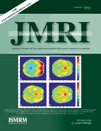Additional value of gadoxetic acid-DTPA-enhanced hepatobiliary phase MR imaging in the diagnosis of early-stage hepatocellular carcinoma: Comparison with dynamic triple-phase multidetector CT imaging
Abstract
Purpose:
To assess the value of hepatobiliary phase gadoxetic acid (EOB)-enhanced magnetic resonance imaging (MRI) for the diagnosis of early stage hepatocellular carcinoma (HCC) (<3 cm) compared to triple-phase dynamic multidetector computed tomography (MDCT).
Materials and Methods:
In all, 52 patients with 60 pathologically proven HCCs underwent both EOB-enhanced MRI and triple-phase dynamic MDCT. Two radiologists independently and blindly reviewed three image sets: 1) MDCT, 2) dynamic MRI (unenhanced and EOB-enhanced dynamic MR images), and 3) combined MRI (dynamic MRI + hepatobiliary phase images) using a five-point rating scale on a lesion-by-lesion basis. Receiver operating characteristics (ROC) analysis was performed, and sensitivity and specificity were calculated.
Results:
The area under the ROC curve (Az) of dynamic MRI was equivalent to that of MDCT for both readers. For both readers, Az and sensitivity of combined MRI for smaller lesions (<1.5 cm) were significantly higher than that of dynamic MRI and MDCT (P < 0.0166). The majority of false-negative nodules on dynamic MRI or MDCT (75% and 62%, respectively) were due to a lack of identified washout findings.
Conclusion:
Hepatobiliary phase images can increase the value of EOB-enhanced MRI in the diagnosis of early stage HCC. The sensitivity and accuracy were significantly superior to MDCT for the diagnosis of lesions less than 1.5 cm. J. Magn. Reson. Imaging 2011;. © 2011 Wiley-Liss, Inc.




